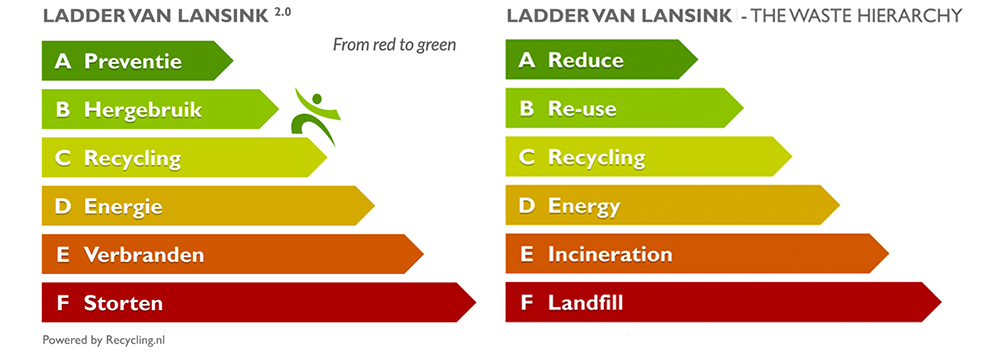Lansink's Ladder
Lansink's ladder is said to have formed the basis of the waste hierarchy or waste management hierarchy. Conceived as a ladder of decision steps it distinguishes five forms of waste management: prevention, reuse, sorting/recycling, incineration and landfilling.
The ladder or steps were later translated to a triangle running in the same order (perhaps because of similarity with energy ratings symbols), with prevention at the top, but it may also now be seen as an inverted triangle with prevention at the top, at its widest, indicating the level of impact each approach might have, ie prevention has the highest level of impact on the overall issues. Ironically, until recently, statistics show that globally incineration and landfill in most countries continues to outweigh other forms of management in terms of what is actually done.
The Ladder of Lansink was adopted in 1979, significantly impacting Dutch waste policy, the Environmental Management Act in 1993, and the European Waste Framework Directive 2008. The Netherlands remains one of the Nations in Europe with the highest rates of recycling.
Ad Lansink worked as a Senior Lecturer in Physical Chemistry at the University of Nijmegen, as Biochemist at the Pathology Department of the UMC Radboud, becoming politically active in the Catholic People’s Party. In the 1977 he was elected to the Dutch parliament and worked on topics such as environment, energy, higher education, science policy and public health. After his parliamentary career, he became a member of the Advisory Board for the state-owned company for the storage of radioactive waste and worked as the Chairman of the Gelderland Environment Federation.
For further information visit https://www.adlansink.nl (in dutch)
[edit] Related articles on Designing Buildings
- Bin blight.
- Circular economy.
- Quantification of construction materials in existing buildings (material intensity).
- Plastic and recycling.
- Recycled waste plastic in construction.
- Recyclable construction materials.
- Recycling.
- Reduce, reuse, recycle.
- Reused construction products.
- UandI Think event with Studio SWINE.
- Waste management plan for England.
- Waste hierarchy for construction
Featured articles and news
Places of Worship in Britain and Ireland, 1929-1990. Book review.
The emancipation of women in art.
CIOB Construction Manager of the Year 2025
Just one of the winners at the CIOB Awards 2025.
Call for independent National Grenfell oversight mechanism
MHCLG share findings of Building Safety Inquiry in letter to Secretary of State and Minister for Building Safety.
The Architectural Technology Awards
AT Awards now open for this the sixth decade of CIAT.
50th Golden anniversary ECA Edmundson awards
Deadline for submissions Friday 30 May 2025.
The benefits of precast, off-site foundation systems
Top ten benefits of this notable innovation.
Encouraging individuals to take action saving water at home, work, and in their communities.
Takes a community to support mental health and wellbeing
The why of becoming a Mental Health Instructor explained.
Mental health awareness week 13-18 May
The theme is communities, they can provide a sense of belonging, safety, support in hard times, and a sense purpose.
Mental health support on the rise but workers still struggling
CIOB Understanding Mental Health in the Built Environment 2025 shows.
Design and construction material libraries
Material, sample, product or detail libraries a key component of any architectural design practice.
Construction Products Reform Green Paper and Consultation
Still time to respond as consultation closes on 21 May 2025.
Resilient façade systems for smog reduction in Shanghai
A technical approach using computer simulation and analysis of solar radiation, wind patterns, and ventilation.
Digital technology, transformation and cybersecurity
Supporting SMEs through Digitalisation in Construction.
Villa Wolf in Gubin, history and reconstruction. Book review.
Construction contract awards down one billion pounds
Decline over the past two months compared to the same period last year, follows the positive start to the year.
Editor's broadbrush view on forms of electrical heating in context.

























